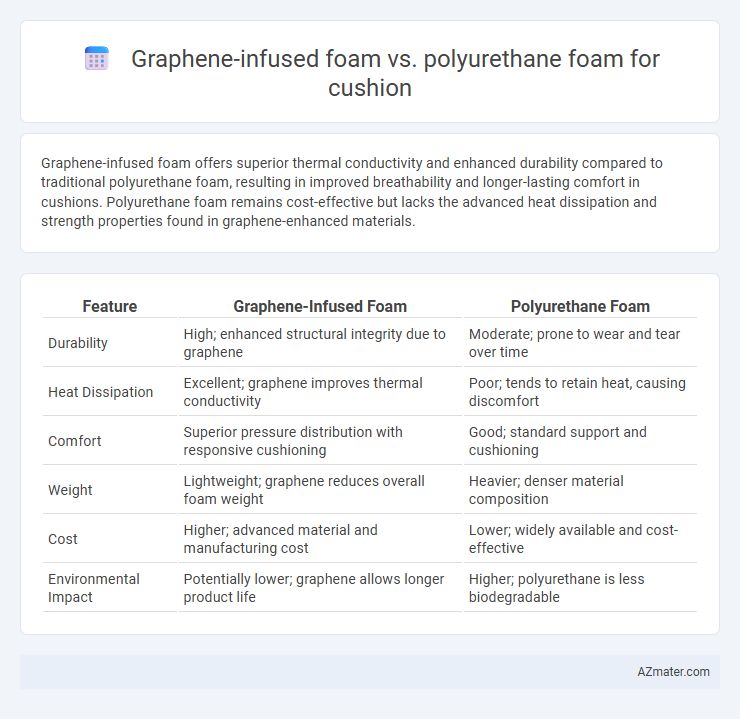Graphene-infused foam offers superior thermal conductivity and enhanced durability compared to traditional polyurethane foam, resulting in improved breathability and longer-lasting comfort in cushions. Polyurethane foam remains cost-effective but lacks the advanced heat dissipation and strength properties found in graphene-enhanced materials.
Table of Comparison
| Feature | Graphene-Infused Foam | Polyurethane Foam |
|---|---|---|
| Durability | High; enhanced structural integrity due to graphene | Moderate; prone to wear and tear over time |
| Heat Dissipation | Excellent; graphene improves thermal conductivity | Poor; tends to retain heat, causing discomfort |
| Comfort | Superior pressure distribution with responsive cushioning | Good; standard support and cushioning |
| Weight | Lightweight; graphene reduces overall foam weight | Heavier; denser material composition |
| Cost | Higher; advanced material and manufacturing cost | Lower; widely available and cost-effective |
| Environmental Impact | Potentially lower; graphene allows longer product life | Higher; polyurethane is less biodegradable |
Introduction to Cushion Foams
Graphene-infused foam offers enhanced durability, superior thermal conductivity, and improved pressure distribution compared to traditional polyurethane foam in cushions. Polyurethane foam remains widely used for its affordability and versatility but can suffer from quicker wear and reduced breathability. Advances in graphene integration provide cushions with longer lifespan and better comfort by optimizing foam structure at the molecular level.
What is Polyurethane Foam?
Polyurethane foam is a versatile synthetic material widely used in cushions for its lightweight, flexible, and durable properties. It provides excellent support and comfort by trapping air within its cellular structure, making it ideal for cushioning applications. Compared to graphene-infused foam, polyurethane foam may lack enhanced thermal conductivity and antibacterial properties but remains cost-effective and highly adaptable for various comfort needs.
Understanding Graphene-Infused Foam
Graphene-infused foam offers enhanced durability and superior thermal conductivity compared to traditional polyurethane foam, making it ideal for high-performance cushions. The integration of graphene nano-platelets into the foam matrix improves its mechanical strength, resilience, and breathability, resulting in longer-lasting and more comfortable seating solutions. This advanced material also provides better pressure distribution and moisture-wicking properties, elevating overall cushion performance in both residential and commercial applications.
Material Composition and Structure
Graphene-infused foam incorporates graphene nanoparticles within the polyurethane matrix, enhancing thermal conductivity and mechanical strength without compromising elasticity, while traditional polyurethane foam consists of a polymeric network of polyols and isocyanates that create a lightweight, resilient cushioning material. The graphene infusion improves load distribution and durability by reinforcing the foam's cellular structure at a nanoscale level, resulting in increased compressive strength and resistance to deformation. Polyurethane foam alone provides excellent cushioning through its open or closed-cell structure but lacks the advanced thermal management and mechanical reinforcement properties introduced by graphene integration.
Comfort and Support Comparison
Graphene-infused foam offers superior heat dissipation and enhanced breathability compared to traditional polyurethane foam, resulting in a cooler and more comfortable cushion experience. Its material structure provides consistent support by adapting to body contours while maintaining durability over time. Polyurethane foam, although widely used for cushioning, tends to retain heat and may compress faster, offering less optimal comfort and support in long-term use.
Durability and Longevity
Graphene-infused foam exhibits superior durability and longevity compared to traditional polyurethane foam, owing to graphene's exceptional strength and resistance to wear. The integration of graphene nanoparticles enhances the foam's structural integrity, reducing deformation and sagging over extended use. This results in cushions that maintain comfort and support significantly longer, making graphene-infused foam an optimal choice for high-performance, long-lasting cushioning solutions.
Thermal Regulation Features
Graphene-infused foam offers superior thermal regulation compared to traditional polyurethane foam due to its excellent heat conductivity and ability to dissipate body heat efficiently. This advanced material helps maintain a cooler sleep surface by preventing heat buildup, enhancing comfort during extended use. Polyurethane foam, while providing decent cushioning, tends to retain heat, which can lead to discomfort and sweat accumulation.
Health and Safety Considerations
Graphene-infused foam offers enhanced antimicrobial properties and improved breathability compared to traditional polyurethane foam, reducing the risk of mold, bacteria, and allergens in cushions. It also dissipates heat more effectively, minimizing heat retention that can cause discomfort or skin irritation during prolonged use. Polyurethane foam may emit volatile organic compounds (VOCs) during off-gassing, posing potential respiratory concerns, while graphene-enhanced cushions typically exhibit lower VOC emissions, contributing to better indoor air quality.
Environmental Impact and Sustainability
Graphene-infused foam offers enhanced durability and thermal conductivity, reducing the need for frequent replacement and lowering overall material waste compared to traditional polyurethane foam. Polyurethane foam production relies heavily on petrochemicals and emits significant volatile organic compounds (VOCs), contributing to environmental pollution and higher carbon footprints. The integration of graphene in foam supports sustainability by improving lifespan and enabling recycling possibilities, positioning it as a more eco-friendly alternative in cushion manufacturing.
Applications and Market Trends
Graphene-infused foam exhibits superior thermal conductivity and enhanced durability compared to traditional polyurethane foam, making it increasingly popular in high-performance cushioning applications such as automotive seating, aerospace, and premium furniture. Market trends indicate a growing demand for graphene-enhanced materials driven by their lightweight, antimicrobial properties, and energy absorption capabilities, positioning this technology as a premium alternative in sports equipment and medical cushioning. Polyurethane foam remains dominant in cost-sensitive markets due to its versatility and affordability but faces pressure from eco-conscious consumers seeking sustainable and high-performance cushioning solutions.

Infographic: Graphene-infused foam vs Polyurethane foam for Cushion
 azmater.com
azmater.com